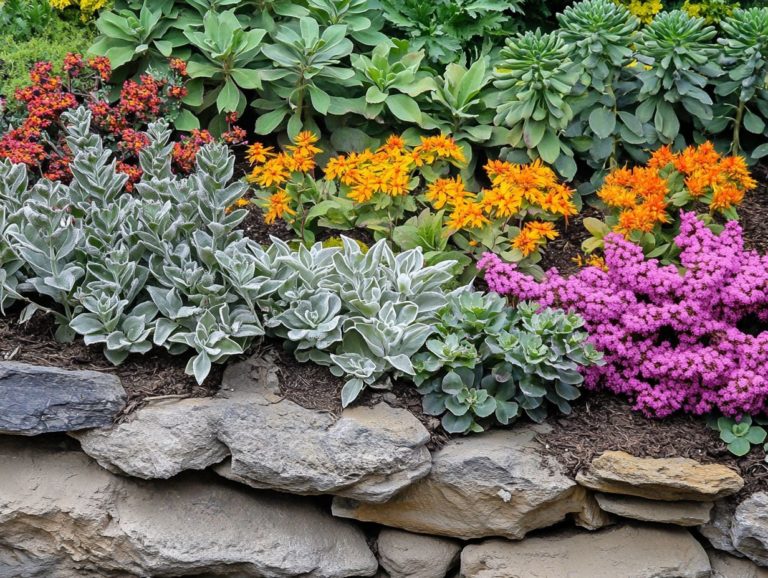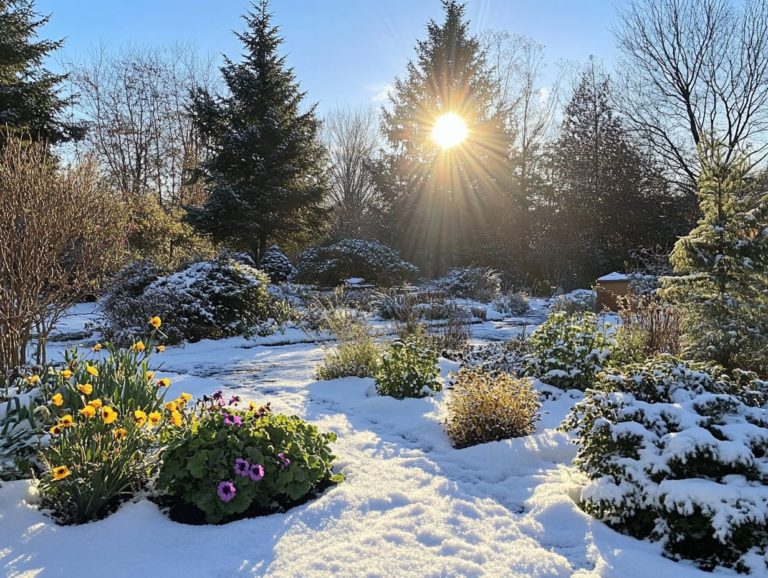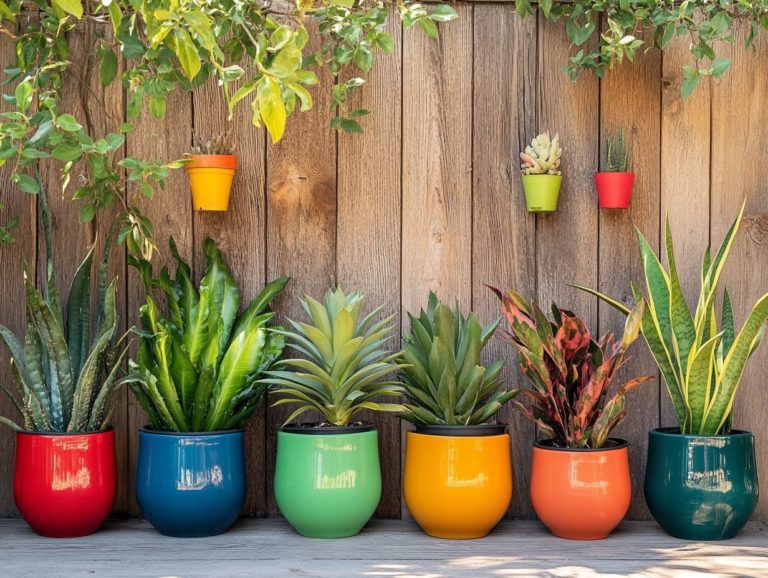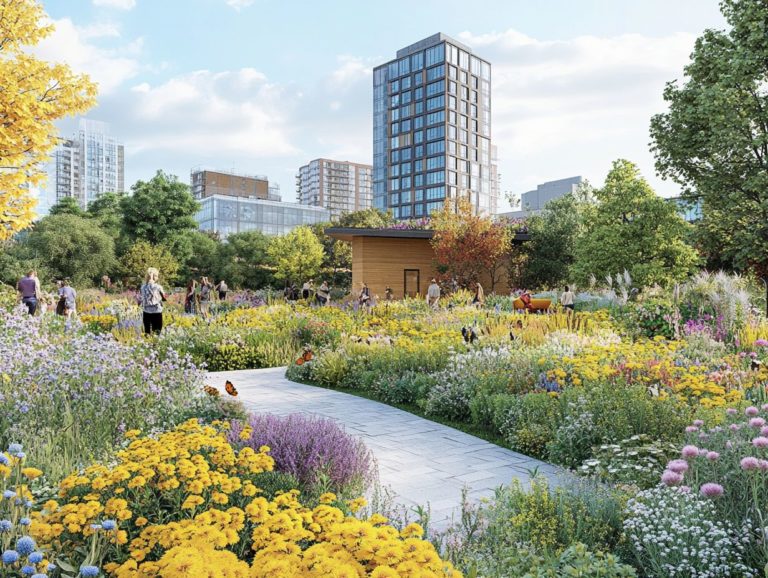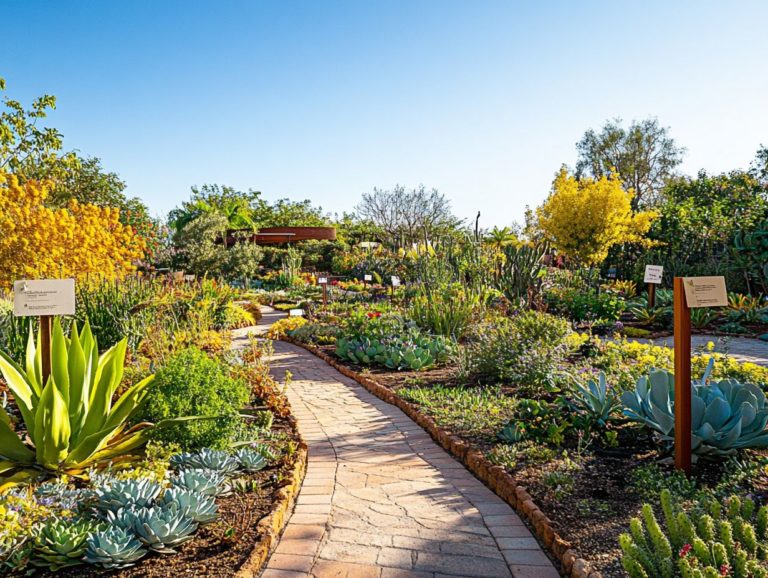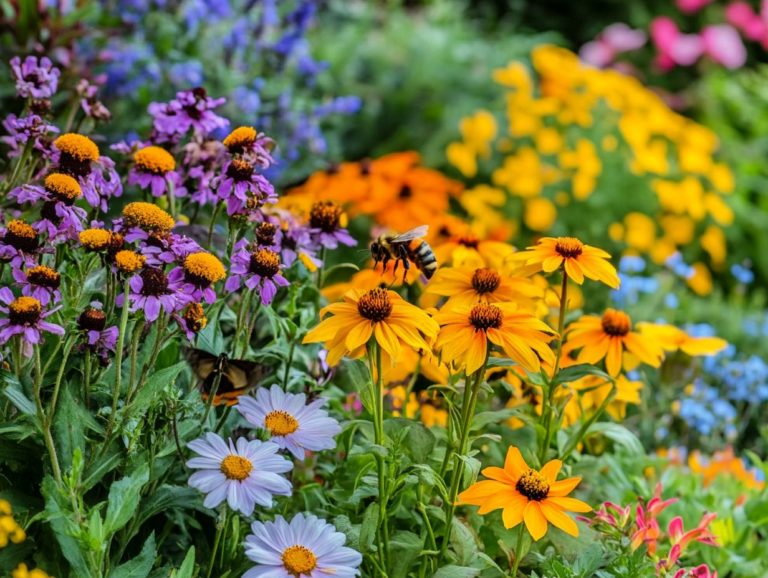“Top Decorative Plants for Permaculture Spaces”
Incorporating decorative plants into your permaculture spaces, especially those that include native plants, elevates aesthetic appeal and bolsters the overall health and functionality of the ecosystem.
By choosing from native, low-maintenance options to edible and medicinal varieties, you can unlock a multitude of benefits. This article delves into a diverse array of decorative plants, their essential roles in permaculture design, and offers insightful tips for selecting the best options for your garden.
Explore how to craft a vibrant, sustainable environment that delights your senses while supporting biodiversity.
Contents
- Key Takeaways:
- 1. Benefits of Decorative Plants in Permaculture
- 2. Choosing the Right Decorative Plants
- 3. Native Plants vs. Non-Native Plants in Permaculture
- 4. Low-Maintenance Decorative Plants for Permaculture Spaces
- 5. Edible Decorative Plants for Permaculture Spaces
- 6. Flowering Plants for Pollinators in Permaculture Spaces
- 7. Climbing Plants for Vertical Gardening in Permaculture Spaces
- 8. Ground Cover Plants for Permaculture Spaces
- 9. Shade-Loving Plants for Permaculture Spaces
- 10. Drought-Tolerant Plants for Permaculture Spaces
- 11. Medicinal Plants for Permaculture Spaces
- 12. Plants for Companion Planting in Permaculture Spaces
- 13. Aesthetic Plants for Permaculture Spaces
- 14. Fragrant Plants for Sustainable Gardening
- 15. Incorporating Decorative Plants in Different Types of Sustainable Gardening Systems
- Common Mistakes in Choosing Decorative Plants for Sustainable Gardening Spaces
- Frequently Asked Questions
- What are the top decorative plants for sustainable gardening spaces?
- How can decorative plants enhance a sustainable gardening space?
- Are there any low-maintenance decorative plants suitable for permaculture spaces in the northeastern USA?
- Can I use decorative plants in my permaculture design for more than just aesthetics?
- What are some tips for incorporating decorative plants into a permaculture space?
- Can I use native plants as decorative plants in my permaculture space?
Key Takeaways:
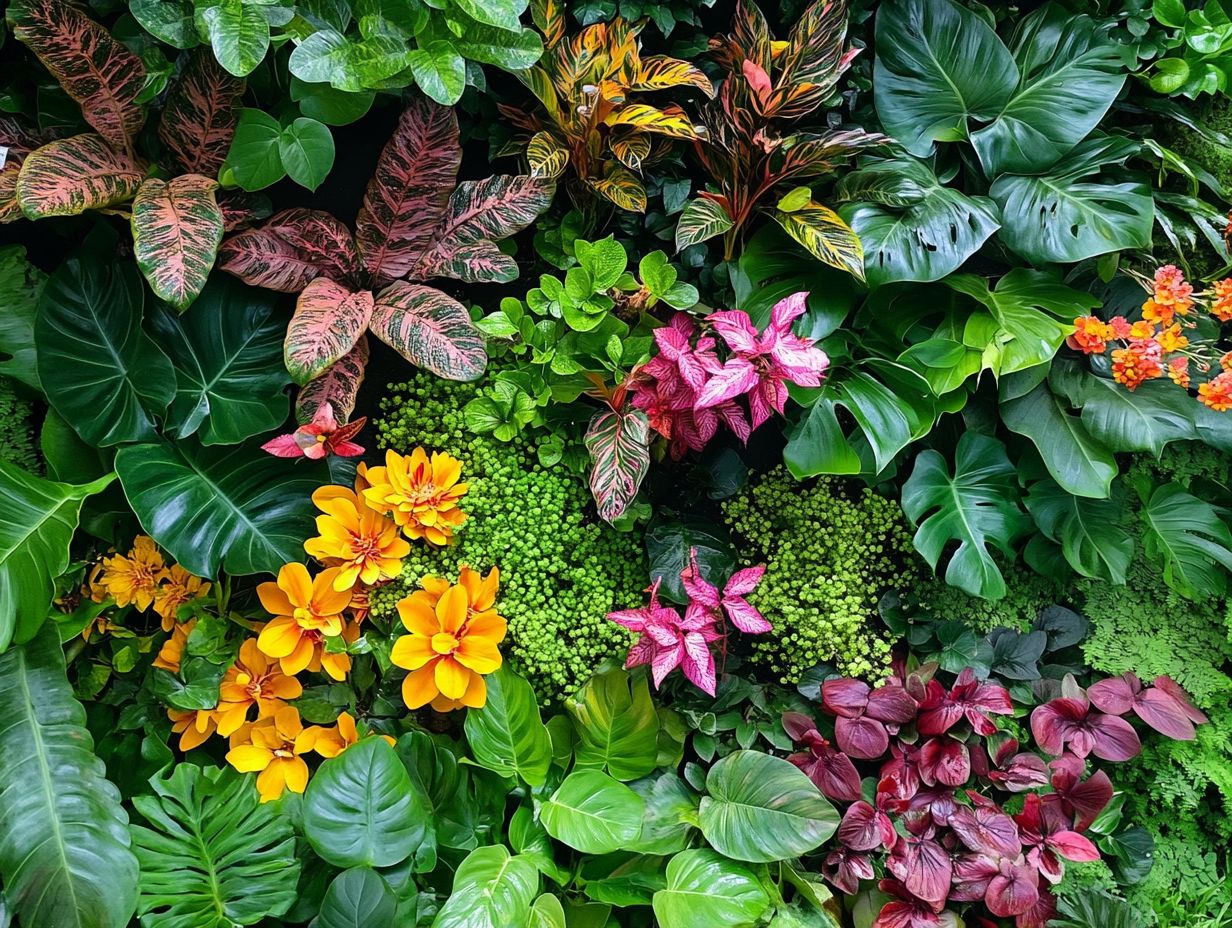
- Decorative plants bring beauty to your permaculture space and attract pollinators!
- Choose plants that are native and low maintenance for the best results.
- Be cautious of invasive species they can harm your garden!
1. Benefits of Decorative Plants in Permaculture
Adding decorative plants to your permaculture space offers many benefits. You ll see a variety of plants and animals, improved soil health, and vibrant habitats for beneficial insects.
Engaging with these plants attracts essential pollinator species like bees and butterflies, which are vital for a healthy garden. Your choices will also provide shelter and food for local wildlife, creating a balanced environment.
The organic matter from these plants aids in composting, promoting nutrient-dense soil that amplifies the effectiveness of your permaculture design.
For example, incorporating flowering varieties like coneflowers and black-eyed Susans elevates the visual appeal of your space while fostering a thriving ecosystem, reaping advantages for both flora and fauna.
2. Choosing the Right Decorative Plants
Selecting the right decorative plants requires careful thought. Consider your soil type, how much moisture it retains, and which native plants will thrive there.
Understanding the acidity of your soil is key. It affects how well plants can absorb nutrients. Monitoring moisture levels is equally important; some plants prefer drier soils while others flourish in more humid environments.
Shade tolerance is critical in plant selection. By opting for plants that can survive and thrive in shaded areas, you can expand your design options and enhance biodiversity.
Evaluating how well these plants fit into the existing ecosystem contributes to a more robust permaculture design, fostering a sustainable environment that supports a variety of wildlife and plant relationships.
3. Native Plants vs. Non-Native Plants in Permaculture
The discussion surrounding native versus non-native plants in permaculture highlights the importance of biodiversity and sustainable practices. Native flora enhances the ecosystem and provides essential resources for local wildlife.
Utilizing native plants supports local pollinator species and beneficial insects, fostering a vibrant ecosystem that naturally manages pests and improves soil health. On the other hand, non-native plants typically need more maintenance due to their struggle to adapt to the local climate, which can lead to a reliance on extra watering or chemical inputs, countering sustainable practices.
Non-native flora can harm local ecosystems by outcompeting native species, resulting in a decline in biodiversity. By choosing to embrace native plants, you can create a healthier garden that aligns with the existing environment, ultimately benefiting both your garden and the wildlife that inhabits it.
4. Low-Maintenance Decorative Plants for Permaculture Spaces
In permaculture, selecting the right plants can make gardening a breeze! You can significantly reduce your gardening efforts by choosing low-maintenance decorative plants, such as drought-tolerant species and effective ground covers. This choice not only streamlines your gardening routine but also supports sustainable practices while enhancing soil health through organic gardening methods.
In the northeastern USA, consider varieties like lavender, sedum, and daylilies. These beauties do more than just adorn your landscape; they play a vital role in helping plants and animals thrive together. By improving soil structure and reducing erosion, these plants help maintain soil fertility, and their extensive root systems excel at retaining moisture.
By opting for such resilient species, you ll minimize the need for irrigation and fertilizers, cutting down on both labor and resource inputs. Thriving in local climates, these plants become integral to a flourishing ecosystem, attracting beneficial insects and providing habitat, all while ensuring that maintenance remains a breeze year after year.
5. Edible Decorative Plants for Permaculture Spaces
Integrating edible decorative plants into your permaculture spaces not only elevates the beauty of your garden but also enhances its functionality. These plants are a treasure trove of greens, fruits, and herbs, all of which can be harvested sustainably while enriching your culinary experiences.
Take Black Huckleberry, for instance. By incorporating this delightful plant, you’ll enjoy delicious berries perfect for jams or desserts, all while supporting local wildlife with a vital food source. Similarly, adding Lavender to your garden opens up a world of culinary possibilities; its fragrant blossoms can be infused into syrups or delicately sprinkled over pastries.
These plants also play a key role in supporting biodiversity, attracting beneficial insects and pollinator species that contribute to a balanced ecosystem. Plus, their deep root systems enhance soil fertility, making them exceptional choices for organic gardening practices that aim to yield bountiful and flavorful harvests.
6. Flowering Plants for Pollinators in Permaculture Spaces
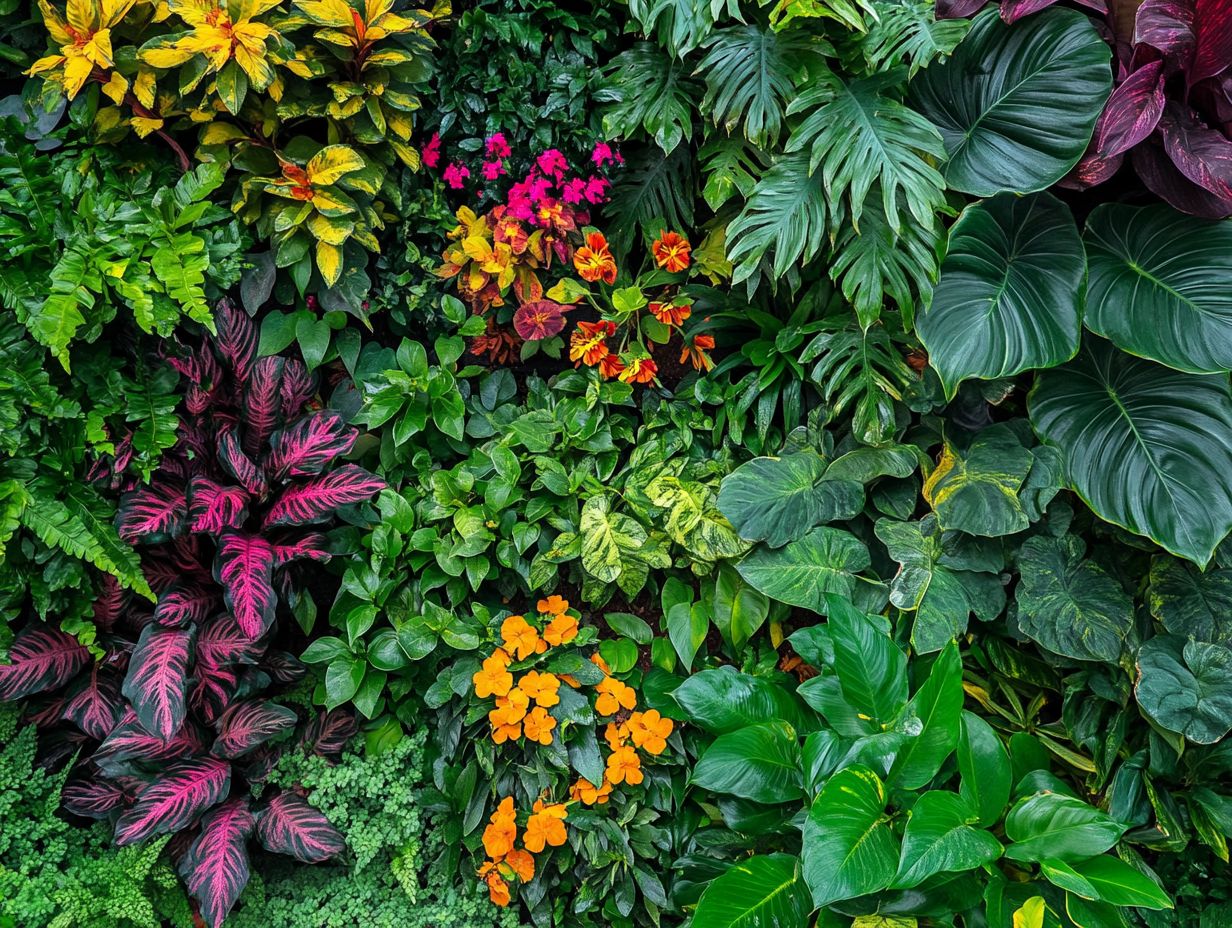
Incorporating flowering plants into your permaculture spaces creates vibrant habitats that are essential for attracting pollinator species, crucial for ecological diversity and enhancing your garden’s productivity.
When you select native varieties, such as Tall Coneflower and Bee Balm, you not only strengthen the local ecosystem but also cater to the specific habitat preferences of these plants, whether in meadows or woodland edges. By integrating such species into your landscape designs, you can craft aesthetically pleasing spaces that simultaneously provide vital support for beneficial insects, like bees and butterflies.
These hardy natives are perfectly adapted to local conditions, making them relatively low-maintenance yet incredibly rewarding, thriving without extensive care. Ultimately, their vibrant blooms inject color and life into your permaculture garden, promoting both ecological balance and visual appeal.
7. Climbing Plants for Vertical Gardening in Permaculture Spaces
Climbing plants are a remarkable choice for vertical gardening in permaculture spaces. They maximize space while offering numerous benefits. These green wonders act as living mulch, enhancing soil health and keeping pesky weeds at bay.
In the northeastern USA, choosing the right climbing plants like peas, beans, and morning glories optimizes your garden space and fosters a vibrant ecosystem. These plants improve soil structure by fixing nitrogen, boosting fertility for neighboring crops. Their abundant foliage provides vital habitat and nourishment for beneficial insects and pollinators.
Transform your garden into a lush paradise today! Incorporating these climbing varieties cultivates a lush, productive environment that contributes to the sustainability of local ecosystems.
8. Ground Cover Plants for Permaculture Spaces
Utilizing ground cover plants in permaculture spaces is essential for moisture retention and enhancing soil fertility. These plants prevent erosion and foster a thriving ecosystem through long-lasting farming methods.
Choosing the right varieties that suit your local conditions in the northeastern USA significantly enhances your garden s health. These plants protect the soil from harsh weather, playing an instrumental role in nutrient cycling.
They form a symbiotic relationship with other plants, boosting biodiversity, attracting beneficial insects, and providing habitat for pollinator species. By thoughtfully selecting these plants, you can cultivate a more resilient ecosystem that thrives on cooperation and harmony within your garden.
What varieties will you choose to enhance your garden?
9. Shade-Loving Plants for Permaculture Spaces
Shade-loving plants are essential in your permaculture spaces, offering unique opportunities for biodiversity and enhancing your garden design. They create diverse habitats that support wildlife and improve overall ecosystem health.
Among these, Virginia Waterleaf and Wood Nettle stand out as exemplary shade-tolerant species. They thrive in moist, rich soil and stabilize the ecosystem in shaded locales, enhancing soil fertility and providing habitat for various species. These remarkable plants prevent soil erosion, while their lush foliage shelters beneficial insects and small wildlife.
By incorporating such plants, you promote habitat diversity and cultivate a balanced ecosystem that can naturally control pests, reducing your reliance on chemical interventions while adhering to sustainable practices.
10. Drought-Tolerant Plants for Permaculture Spaces
Drought-tolerant plants are essential for your permaculture spaces, especially in regions facing water scarcity. They play a significant role in moisture retention and support sustainable practices.
Integrating these native plants reduces the need for extensive watering and plays a crucial role in soil management. They improve soil structure, enhancing drainage and nutrient retention, which benefits other plants in your environment, including seasonal greens and other edible parts.
These plants attract diverse pollinators, enriching your ecosystem. This biodiversity is vital, especially under challenging conditions, as it strengthens habitat stability and supports wildlife. In turn, this creates a thriving balance that is more resilient to climate fluctuations and enhances overall ecological diversity.
Start your journey with drought-tolerant plants today!
11. Medicinal Plants for Permaculture Spaces
Incorporating medicinal plants into your permaculture spaces boosts biodiversity. You ll gain valuable resources for herbal tea and natural remedies.
Take comfrey; its well-known wound-healing properties make it a nourishing mulch that enhances soil quality. This creates a strong relationship within your ecosystem, especially through compost tea.
The vibrant flowers of calendula attract pollinators and can be made into soothing salves for skin ailments. By integrating these herbs into your garden, you cultivate a diverse and resilient permaculture system.
This system not only supports your health and wellness but also encourages beneficial organisms to thrive. It promotes a balanced environment through organic matter and living mulch.
This dynamic interplay shows how chosen plants can elevate productivity and sustainability in your gardening endeavors.
12. Plants for Companion Planting in Permaculture Spaces
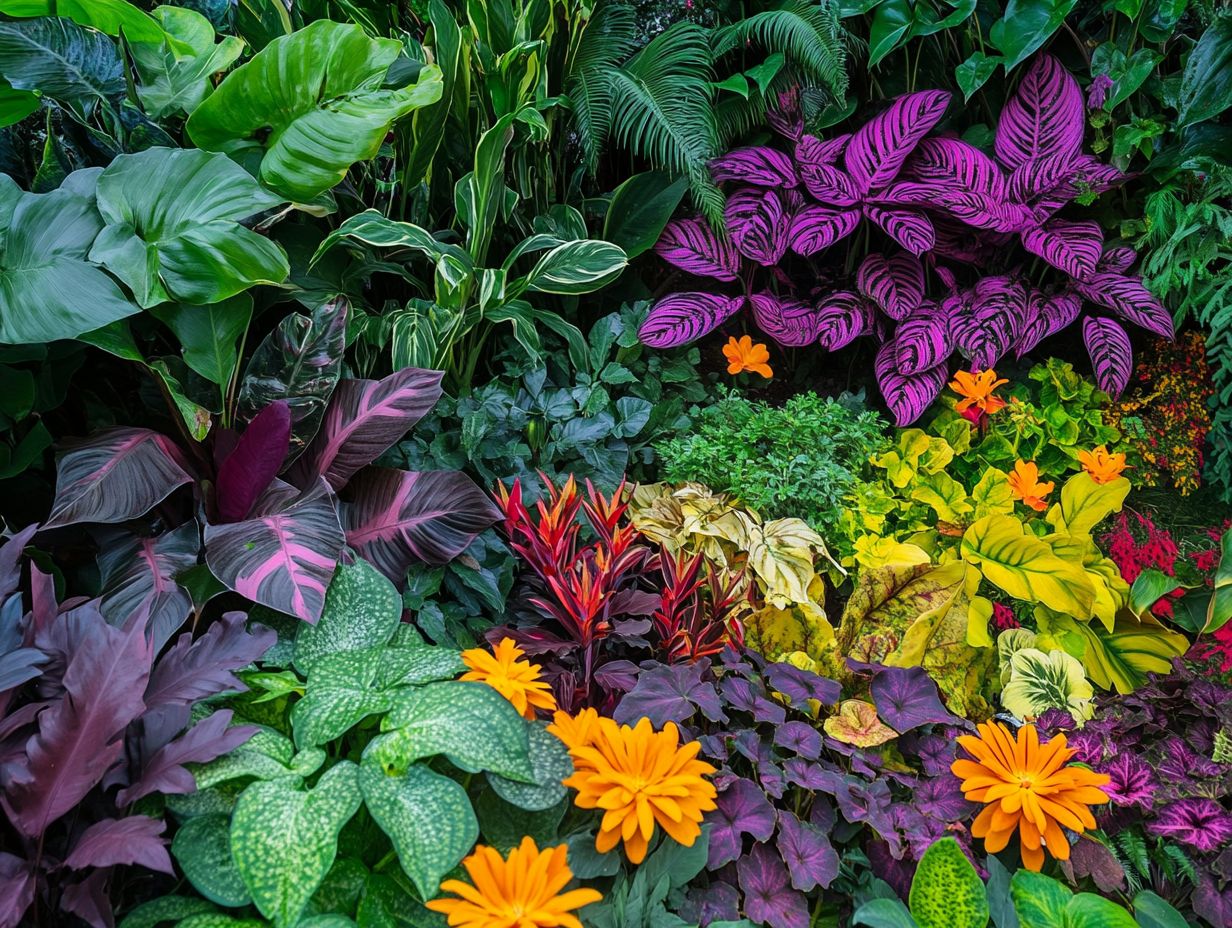
Companion planting is vital in permaculture spaces. Your plant choices can boost soil fertility and promote biodiversity.
By pairing plants thoughtfully, you create a harmonious ecosystem that naturally deters pests. For example, pairing tomatoes with basil not only enhances flavor but also repels invaders like aphids.
Consider planting marigolds alongside vegetables for natural pest control. These practices increase productivity and promote a resilient environment for your vegetable gardening efforts.
This allows your plants to thrive together in a mutually beneficial relationship, which enhances overall health and reduces the need for synthetic fertilizers and pesticides.
13. Aesthetic Plants for Permaculture Spaces
In permaculture, aesthetic plants do more than beautify the landscape. They support biodiversity and enrich community gardening efforts.
By selecting a variety of ornamental species, including flowering stems, you create vibrant ecosystems that attract beneficial insects. This not only enhances the garden s visual appeal but also boosts its ecological health.
These plants add layers of texture and color, creating a stunning visual that invites community involvement. As members participate in planting and upkeep, they build relationships and a sense of responsibility for the environment.
This engagement fosters an appreciation for nature s beauty and highlights the vital role ornamental plants play in a thriving permaculture landscape.
14. Fragrant Plants for Sustainable Gardening
Fragrant plants in your sustainable gardening space do more than just please the senses; they attract insects that help plants grow by spreading pollen and enhance the garden’s overall biodiversity, all while offering delightful culinary spices for your cooking.
Take herbs like basil, rosemary, and lavender, for instance. They not only bring unique flavors and enticing aromas to your recipes, but their vibrant blooms also act as a beacon for bees, butterflies, and other wildlife, creating a rich habitat for wildlife.
By incorporating these aromatic beauties, you can craft a visually stunning landscape that flourishes with ecological balance. Plants such as dill and fennel not only elevate your culinary experience but also provide shelter for ladybugs and other predatory insects, naturally managing pest populations.
In this harmonious setting, the interplay of fragrance, flavor, and wildlife support enriches your gardening experience, making it truly rewarding, especially when considering perennial agriculture.
15. Incorporating Decorative Plants in Different Types of Sustainable Gardening Systems
Incorporating decorative plants into your sustainable gardening systems is essential for enhancing biodiversity and achieving a functional garden design. Whether you’re involved in urban agriculture, community gardening, or larger permaculture projects, it’s crucial to find a harmonious balance between aesthetics and utility.
These plants also enhance the ecosystem by attracting helpful insects and pollinators. They enrich soil health and provide habitats for wildlife.
Think of decorative plants as your gardening allies they can act as companion plants, naturally deterring pests while promoting a healthy, integrated approach to gardening through vegetable gardening practices. This thoughtful integration fosters a thriving habitat that aligns with your broader goals of sustainable gardening, enhancing both your enjoyment and your commitment to environmental stewardship.
Common Mistakes in Choosing Decorative Plants for Sustainable Gardening Spaces
Selecting decorative plants for your sustainable gardening spaces can sometimes lead to common missteps, particularly when overlooking ecological diversity and the importance of native plant selection, including Common Milkweed and Black Huckleberry. These elements are vital for ensuring long-term sustainability and resilience.
One common pitfall is opting for species that simply don t thrive in your local climate or soil, which can lead to increased maintenance and resource consumption. To sidestep these issues, it s crucial to assess the specific conditions of your planting area consider factors like sunlight, soil type, and moisture levels.
Integrating local flora not only enhances biodiversity but also supports the native wildlife in your area, creating a more resilient wildlife habitat. By embracing practices such as researching indigenous plants, including Virginia Waterleaf and Wood Nettle, and understanding their roles in the ecosystem, you set the stage for a flourishing landscape that remains vibrant and healthy over time.
Watch this video for tips on growing fragrant plants!
Frequently Asked Questions
What are the top decorative plants for sustainable gardening spaces?
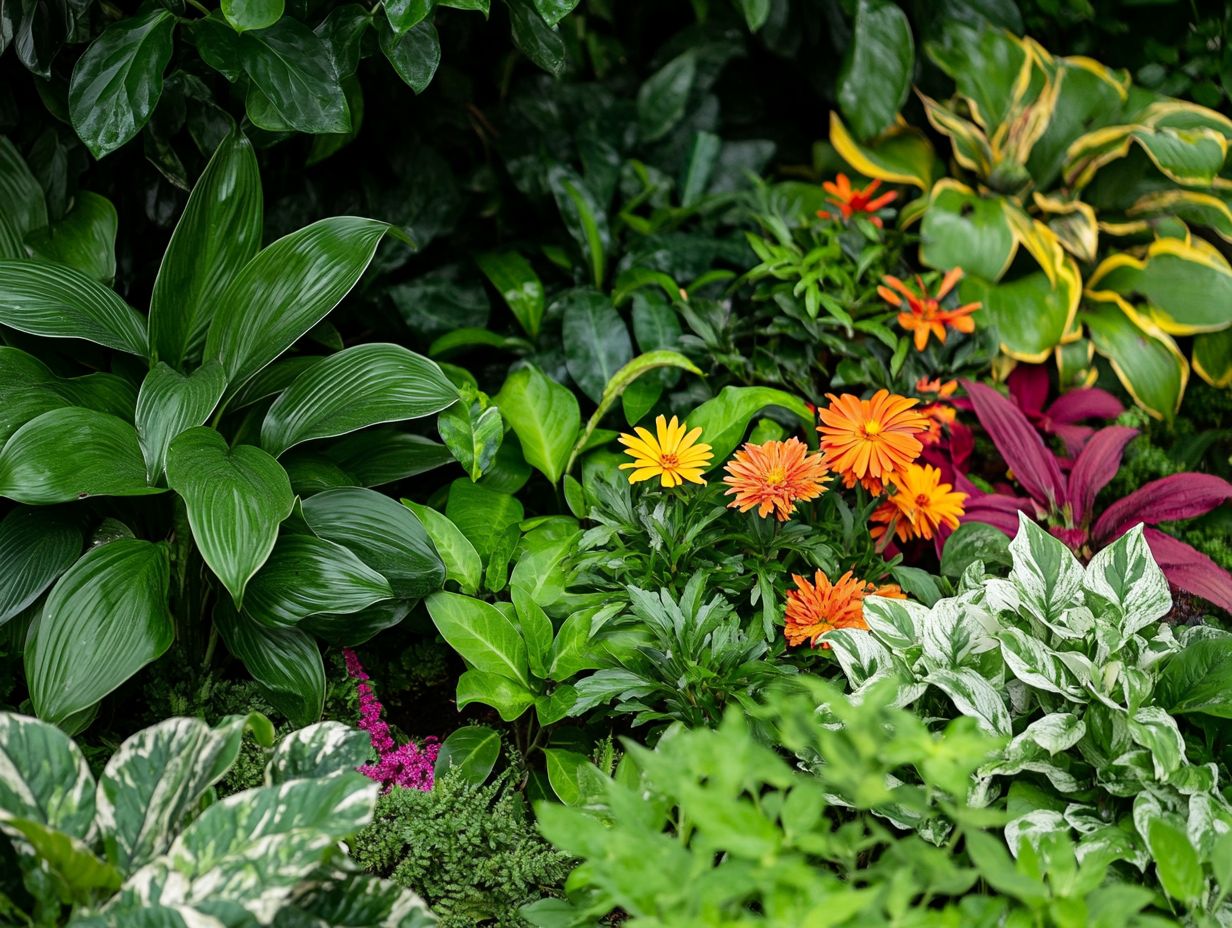
- Lavender
- Rosemary
- Sage
- Butterfly bush
- Peonies
These plants enhance both aesthetic value and ecological function.
How can decorative plants enhance a sustainable gardening space?
Decorative plants not only add visual appeal to a sustainable gardening space, but they can also attract helpful insects and pollinators, improve soil health, and provide food and shelter for wildlife, promoting overall biodiversity.
What are your favorite plants or experiences in sustainable gardening? Share with us!
Are there any low-maintenance decorative plants suitable for permaculture spaces in the northeastern USA?
Great news! You can find many low-maintenance decorative plants perfect for permaculture spaces. Consider native plants like Common Milkweed, Black Huckleberry, and Virginia Waterleaf. Some examples include yarrow, coneflowers, sedum, and ornamental grasses.
Can I use decorative plants in my permaculture design for more than just aesthetics?
Absolutely! Some decorative plants, such as culinary herbs and herbal tea plants, serve multiple functions in permaculture. They can provide medicinal properties, repel pests, and be used in cooking or herbal remedies.
What are some tips for incorporating decorative plants into a permaculture space?
When selecting decorative plants for a permaculture space, consider their growth habits and growing conditions. Select a variety of plants to create a diverse and resilient ecosystem.
Can I use native plants as decorative plants in my permaculture space?
Yes! Using native plants as decorative plants in a permaculture space is highly recommended. Native plants like Blackcap Raspberry and Wild Columbine thrive in the local climate. They also attract a diverse range of wildlife, enhancing ecological diversity.

